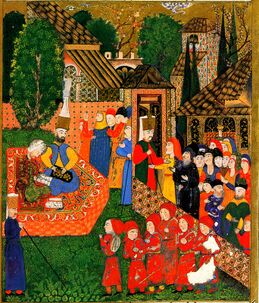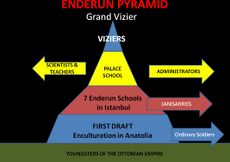دڤشيرمه

الدِّوشيرمة أو الدِّڤشيرمة (بالتركية: devşirme) هي الممارسة الذي بموجبها كانت الدولة العثمانية تجنّد أولاداً من عائلات مسيحية، يتم تحويلهم بعد ذلك إلى الإسلام ويدربون كجنود إنكشارية. تنبع هذه الممارسة من الرغبة بإنشاء طبقة عليا من المحاربين تكون موالية فقط للسلطان، لا للنبلاء العثمانيين. وكانوا يعينون إما فرساناً، يسمون كاپيقولو سواري (أي فرسان خدم الباب العالي) أو مشاة ويسمون يني چري (أي القوات الجديدة، والتي حرفت إلى إنكشارية) وكانوا في الحالتين يرتقون سلم الوظائف الإدارية للإمبراطورية. وقد بدأ تلك الممارسة السلطان مراد الأول.
كانت السلطة العثمانية في البلقان تأخذ كل خمس سنوات تقريباً صبياً من كل أربعة صبية بين عمر عشر سنوات إلى عشرين سنة من المسيحيين كضريبة راس خاصة. وهذه الضريبة كانت تعرف بالدفشرمة حيث يتحول الصبي إلى الإسلام ويتم تعليمه وتربيته أفضل تربية في معسكرات خاصة وبعدها يعين إما في الفرسان أو المشاة الإنكشارية ثم انتهى هذا النظام في القرن السابع عشر.
كون الشريعة الإسلامية تمنع الدولة الإسلامية من استعباد أهل الذمة، فإن العائلات المستهدفة كانت بالأساس من الشعوب السلاڤية أو تلك التي لم يكن أسلافها مسيحيين أيام النبي محمد. هذه الشعوب اعتبرت عبيدا شرعيين للسلطان، لا أهل ذمة.
الدڤشيرمه في مدرسة القصر العثماني
The primary objective of the Palace School was to train the ablest children for leadership positions, either as military leaders or as high administrators to serve the Devlet.[3] Although there are many resemblances between Enderûn and other palace schools of the previous civilizations, such as those of the Abbasids, and Seljuks[4][صفحة مطلوبة] or the contemporary European palace schools, Enderûn was unique with respect to the background of the student body and its meritocratic system. In the strict draft phase, students were taken forcefully from the Christian population of the Empire and were converted to Islam; Jews and Gypsies were exempted from devşirme, and so were all Muslims.
انظر أيضاً
الهامش
- ^ Nasuh, Matrakci (1588). "Janissary Recruitment in the Balkans". Süleymanname, Topkapi Sarai Museum, Ms Hazine 1517. Archived from the original on 3 December 2018. Retrieved 20 November 2016.
- ^ Finkel, Caroline (2007). Osman's dream : the story of the Ottoman Empire, 1300–1923. Basic Books. p. 325. ISBN 978-0465023967.
- ^ Basgoz, I. & Wilson, H. E. (1989). The educational tradition of the Ottoman Empire and the development of the Turkish educational system of the republican era. Turkish Review 3(16), 15.
- ^ Van Duinkerken, W. (1998). Educational reform in the tanzimat era (1839–1876): Secular reforms in tanzimat (Unpublished masters thesis, McGiIl University). Retrieved from http://digitool.library.mcgill.ca:1801/webclient/StreamGate?folder_id =0&dvs=1248070802480~852
المصادر الخارجية
- "Devsirme" in "Encyclopaedia of the Orient"
- Website on the Ottoman empire - original German version; here its Janissary page (to be further exploited)
- Papoulia, B.D., Ursprung und Wesen der “knabenlese” im Osmanischen Reich. München, 1963 (in German, title means 'origin and nature of the 'boy harvest' in the Ottoman Empire)
- Short description is different from Wikidata
- مقالات بالمعرفة بحاجة لذكر رقم الصفحة بالمصدر from June 2020
- Pages using country topics with unknown parameters
- دڤشيرمه
- كلمات تركية
- التعليم في الدولة العثمانية
- Military of the Ottoman Empire
- Slaves of the Ottoman Empire
- Persecution of Christians in the Ottoman Empire
- Persecution of Greeks in the Ottoman Empire before the 20th century
- Ottoman culture
- Society of the Ottoman Empire
- Slave soldiers
